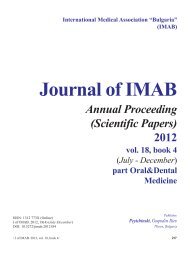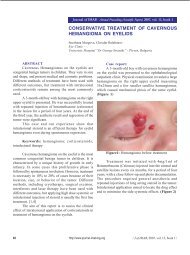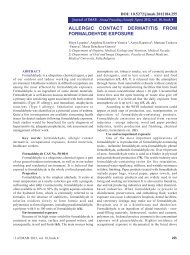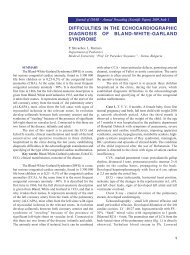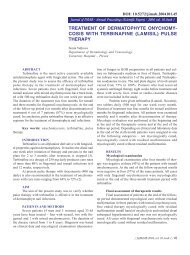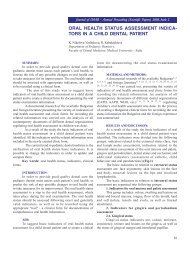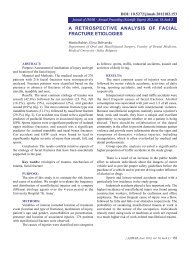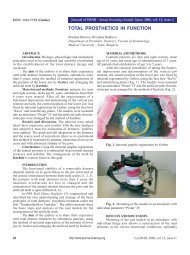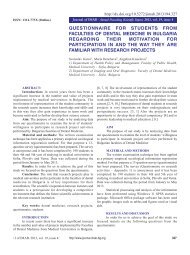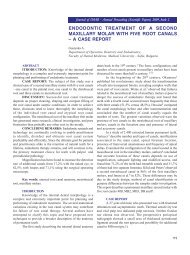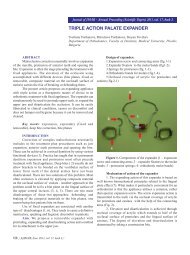download pdf - Academic Journals Database
download pdf - Academic Journals Database
download pdf - Academic Journals Database
Create successful ePaper yourself
Turn your PDF publications into a flip-book with our unique Google optimized e-Paper software.
ISSN: 1312-773X (Online)http://dx.doi.org/10.5272/jimab.2013193.448Journal of IMAB - Annual Proceeding (Scientific Papers) 2013, vol. 19, issue 3RECOVERY ASSESSMENT OF DAILY ANDLABOUR ACTIVITIES (FOOD PREPARING ANDFEEDING) IN PATIENTS WITH CEREBRO-VASCULAR DISEASEDanelina Vacheva 1 , Verjinia Simeonova 2 , Boyko Stamenov 2 .1) Clinic of Physical Medicine and Rehabilitation, University Hospital “Dr. G.Stranski” Pleven, Bulgaria2) Faculty of Physical Medicine, Rehabilitation, Ergotherapy and Sport, MedicalUniversity - Pleven, Bulgaria.ABSTRACTBulgaria is in a leading position concerningmorbidity and mortality rate from cerebrovascular disease(CVD). The goal of this research was to examine, followup and assess the recovery and the ability for foodpreparation and feeding in patients with CVD.Materials and methods: Sixty one patients wereincluded in the research. All of them underwent physicalrehabilitation program, based on their individual status.The program included: kinesitherapy, labour-therapy[(occupational therapy (OT) and activities of daily life(ADL)]; electrotherapy. The patients were assessed twice:in the beginning and at the end of the rehabilitationcourse. They self evaluated the basic parametersnevertheless which of the limbs was particularly affected.Wilcoxon rank test was used for the statistical analysisof non parametrical data and distribution.Results and analysis: At the end of the rehabilitationcourse the Wilcoxon’s curves were found shifted to theright, which confirmes improvement of the main parameter(self independence in the main task set to be fulfilled), nomatter which limb was paretic.Conclusion: Early initiation of the rehabilitationcourse including labour activities and elements of ADL,given as instructions is essential for achieving betterresults in the rehabilitation of patients with CVD and forenhancing the self service ability. Functional OT stimulatesthe independence of patients and facilitates theirrecovering to independent everyday life and socialactivities.Key words: rehabilitation, occupational therapy,cerebro-vascular diseaseINTRODUCTIONBulgaria is in a leading position in the world asregards morbidity, sick rate and mortality of CVD (1).Recently, young adults are often affected. Severedisability as motor disorders, difficulties with self service,professional and social dysadaptation, impaired quality oflife and depression are the main consequences of CVD. (2-4)About 80% of the survivors from a cerebrovascularvascular incident overcome the dependence of otherpeople’s help, about 26% of them were diagnosed withvascular dementia and impairment of communication, andabout 20% remain confined to their bed (5-8).Causes for this epidemic of CVD are increasing thefrequency of risk factors such as atherosclerosis of thebrain vessels, arterial hypertension, chronic ischemic heartdisease, overweight, diabetes mellitus, malnutrition,alcohol abuse and smoking, chronic stress, etc. (9).Physical and rehabilitation medicine is of vitalimportance for optimal recovery and saving selfdependenceability achieved in patients with consequencesof CVD, as in the beginning of the rehabilitation processthe stress is mainly on everyday activities (10-11).AIM AND TASKS OF THE SURVEYThe aim of our research is to investigate, follow upand assess the recovery level of important activities ineveryday life (ADL), namely the ability of food preparationand feeding in patients with CVD.The tasks were:1. To select an adequate test for registring by theself service level (food preparation and feeding) of thepatients by appropriate indexes before and after therehabilitation course in the subacute period of the disease(12).2. To detect the level of improvement of self serviceas a result of the physical rehabilitation program at theend of the first rehabilitation course.3. To analyze the obtained results and to recommendactivities concerning facilitation and improvement of selfservice (food preparation and feeding) in patients withconsequences of CVD.448 http://www.journal-imab-bg.org / J of IMAB. 2013, vol. 19, issue 3 /
4. To analyze the dependency of daily and labouractivities ensuing from the paretic limb-dominant (DL) ornon dominant (NDL).MATERIALS AND METHODSDuring the period 2011-2012 year 61 patients withconsequences of CVD (23 women and 38 men, 37 - 75years old), were admitted at the Department of HospitalRehabilitation and the Clinic of Physical medicine andrehabilitation, University Hospital “Dr. Georgi Stranski” –Pleven, Bulgaria.A right-sided paresis was found in 37 of the patients,34 of them were with NDL affected (table 1). The side ofthe paretic limb was of decisive importance for ADL (13-14).Table 1. Distribution of patients by DL and NDLaffectedAll of the patients followed physical rehabilitationprogram consistent with their individual status. It generallyincluded: kinesitherapy; labor therapy (OT and ADL),electrotherapy (15-17).All patients were tested for ADL at the beginningof the rehabilitation course . This test was created by H.Rusk at the Centre of medical rehabilitation , New York.Four stages were included in it - personal grooming andhygiene, putting on shoes, dressing; food preparation andfeeding; different social and labor activities (18).The assessment is based on a 6-grade score (from0 to 5), and the patients assessed themselves followingbasic activities no matter a dominant or NDL was affected:grade 0 - the tested patient cannot perform theactivity;grade 1 - the tested patient is trying to do theactivity but needs significant help;grade 2 - the tested patient is doing the activity, butneeds an assistant to oversee it;grade 3 - the tested patient is doing the activityslowly and with limited capacity;grade 4 - the tested patient is doing the activity withalmost normal power, velocity, coordination and durability;grade 5 – the tested patient performs the activitynormally, with good quality, totally independent;Signs (+) and (–) are given when marks are not full.For the purpose of our research, we focused onlyon ADL, particularly activities for preparing food andfeeding (19-21).The results from the first rehabilitationcourse were processed (subacute period at the start andat the end of the research). This was about one month afterthe stroke onset.Activities for preparing food and feeding: set in/pullout a plug, turning on/off a heater switch, turn on/off awater tab, washing up kitchen utensils, pouring anddrinking liquids in a cup, serving the food in a plate,feeding with a spoon, feeding with a fork, cutting productswith a knife, cleaning the table.These are activities from everyday life that everyperson confronts with. Using the switches of a heaterrequires significant strength for clutching and enoughvolume motion in the radio-ulnar joint. At the beginningof the rehabilitation process this is difficult, evenimpossible, for most of the patients. This situation requiresconsiderable support of the healthy limb, especially whenthe DL is paretic, grasping the clutch and supporting thelocomotion for turning over the switch.Switching on and especially switching off requiresconsiderable strength of the palmar grasp, acting of thehealthy limb is needed, while the paretic limb supports thecontact, (if possible) - figure 1).Fig. 1.The turning on/off of a tab water is not such adifficult activity, especially if it is a pick up/down nozzle,but if it is atraditional one, with hand clutches that turn, itrequires also considerable strength and enough motion in/ J of IMAB. 2013, vol. 19, issue 3 / http://www.journal-imab-bg.org 449
the radio-ulnar joint. We recommend the patients to includethe paretic limb (if possible) and to support the motionwith the healthy limb (figure 2).non-liquid food or a fork, the clutch in most cases beingin position pronation of the ante brachium.When patients are using a knife, they should be verycareful. A person might have difficulties with NDL and he/she may injure by accident the paretic limb. So the knifeshould be at a distance from the food fixed by the pareticlimb. The food must not to be too hard (frozen meet,butter) and must be positioned on a non-slipping surface.If the NDL is affected, the attention of the patient shouldbe towards its fixing role - if there is enough strength tohold the cutting object and to keep in mind his/her status(figure 3).Fig. 2.When washing plates one must be very careful, ifplates are fragile. Beware of slipping, breaking down andeventually cutting themselves. The plate must be held withthe healthy limb while the paretic one is doing the washingwith gel and sponge; and for rinsing the activities of thehands may be changed.When pouring liquids in the glass, the patients mustkeep in mind the weight of the bottle. It should not be tooheavy. The intact hand mainly takes the weight, while theparetic one is only supporting pouring into cup. Werecommend turning on and off of the stopper to beperformed with the paretic limb (if possible), and thehealthy one supports the activity,if needed.When drinking liquids from a glass we recommendthe use of the paretic limb, but taking in consideration theweight and material which the cup is made of - not tooheavy, of anti-fragile materials and with the biggestpossible diameter. This stimulates the cylindrical clutch andtrains extensor muscles of the fingers and the wrist.When the DL was affected the pouring of food in aplate and feeding becomes significantly difficult. In thiscase we recommend using a deeper food plate, placed onthe plot of the table and then the paretic limb slowly andcarefully moves to it. If not impossible to perform thisactivity by the DL, in the beginning of the recoveringprocess it has be perform with the intact one.In the beginning of the recuperation the patientswith DL affected are advised to feed themselves with thehealthy limb, in order not to be depressed additionally ,then gradually to include the paretic one. We recommendthe affected limb to hold a piece of bread, a spoon withFig. 3.In the process of cleaning the table with both limbsone of them takes the cleaning object and the other thekitchen spade. The activity of both hands can be changedalternatively. The affected limb plays a supportivefunction.RESULTS AND ANALYSISThe results of the tests were recorded in a speciallydeveloped individual patient card. The data of the studywere processed with a statistical computer programSTATGRAPHICS, WINDOWS, EXCEL and Wilcoxon ranktest (a statistical method for analyzing of non-parametricaldata and distribution).The significance of the results for conclusions andkey points have been determined at P < 0, 05.On table 2 we present the curve of the Wilcoxonexpressing the results for the activity „feeding with aspoon” in all the patients at the beginning and at the endof the first rehabilitation course.450 http://www.journal-imab-bg.org / J of IMAB. 2013, vol. 19, issue 3 /
Table 2. Results for the activity of „feeding with a spoon” at thebeginning and at the end of the rehabilitation course.Similar were the results for the activities as washingdishes, serving food in a plate and cutting, which are verydifficult for patients with PL.On table 3 are presented the results for the activitiesas switching on/off of a heater, plugging in/out, turningon/off of a water tap, drinking from a cup, feeding with afork, cleaning the table, which can be successfullyperformed by the NDL and are not so difficult for thepatients.Table 3. Results for the activity “switching on/off a heater” at thebeginning and at the end of the rehabilitation courseCONCLUSIONSAfter receiving the double-peaked Wilcoxon’s curvein some of the studied activities we made the conclusionthat preparing food and feeding is much more difficult forthe patients with paretic DL as compared with those withparetic NDL.The Wilcoxon’s curve forms a peak in the activitiesthat can be performed by the healthy limb (equally well byDL or NDL) and they don’t provide significant difficulty insome patients activities such as preparing food and feedingeven at the beginning of the rehabilitation process. At theend of the rehabilitation course the Wilcoxon’s curves wasfound shifted to the right, which means improvement in theself independence of the patients with a DL or a NDL.A significantly positive influence of the functionalmotion of the paretic limbs and the intensity of the pain ofthe humero-scapular joint was observed./ J of IMAB. 2013, vol. 19, issue 3 / http://www.journal-imab-bg.org 451
SUMMARYEarly initiation of the rehabilitation including labouractivities and elements of ADL, given as instructions is ofsignificant importance for achieving better results in therehabilitation course of patients suffering from CVD and forenhancing their ability of self service. Functional OTstimulates the independence of patients and facilitates theprocess of recovery to independent everyday life and socialactivities.REFERENCES:1. Yiancheva S, Milanov I, GeorgievD, Shotekov P. Motor activity. In:Yiancheva S, (ed) Neurology - Generalneurology. Stara Zagora: College, 1998.[in Bulgarian]2. Kaplan EY, Tsirenjapova OD,Shantanova LN. Optimization of theadaptive processes of the organism. M.,Nauka. 1990; 94p. [in Russian]3. Pedretti LW, Early MB. (2001).Occupational therapy: Practice skillsfor physical dysfunction. (5th ed.) St.Louis, MO: Mosby.4. Radomski MV, Trombly CA.Occupational Therapy for PhysicalDysfunction. Baltimore, MD [etc.]Wolters Kluwer/Lippincott Williams &Wilkins, 2008.5. Gencheva N. Classificationalsystem for manual capacity (MAGS) inchildren with cerebral palsy. Sport iNauka, 2011; 1: 60 - 65. [in Bulgarian]6. Mihaylova N. OccupationalTherapy in some degenerative diseasesof the motor support apparatus. - In:Topuzov I, (ed) Occupational Therapy:2nd part. Sofia: RIK „Simel”, 2008; 153-155. [in Bulgarian]7. Petkova I. Interactive methods ineducators’ qualification, Qualyeducayion for all through improvingteacher training. Paradigma, 2010; 214-216. [in Bulgarian]8. Punwar AJ, Peloquin SM.Occupational Therapy: Principles andPractice. 3rd edn. Lippincott Williams &Wilkins, 2000; pp.303.9. Delank H. Neurology. Sofia: MI„Sharov”, 1996. [in Bulgarian]10. Sinaki M. Basic clinicalrehabilitation medicine. Toronto –Philadelphia: W. B. Saunders Co, 1987.11. Slanchev P, Bonev L, Bankov St.Textbook on Kinesitherapy. Medicina iphyscultura, Sofia. 1986. [in Bulgarian]12. Karaneshev G, Milcheva D.Methods for diagnostics andexamination in remedial gymnastics.Sofia: National Sport Academy, 1984. [inBulgarian]13. Hannecke van Bruggen. Occupationaltherapy (ergotherapy) - philosophy,objectives and methodology.Rehabilitation Medicine and the Qualityof Life, 2007; 2:16.14. Kielhofner G. (ed.) (2008)Model of human occupation: theoryand application, 4th edn. LippincottWilliams & Wilkins.15. Busarov St. Basis of themedicine-social rehabilitation. Sofia:Medicina i physcultura, 1982. [inBulgarian]16. Koleva I. Physical analgesia inneurological diseases. Cephalgia, 2006;8(1):10-21. [in Bulgarian]17. Mollova K, Paskaleva R.Rehabilitation activities in patients withmotor dosturbancer. Collection ofmaterials. International cientificconferention; Stara Zagora,s bads, 2009.[in Bulgarian]18. Rusk HA. RehabilitationMedicine: A Textbook on PhysicalMedicine and Rehabilitation, 2nd Edn,Mosby Co, St. Louis. 1964. 668 pp.19. AOTA Council on Standards.Occupational therapy – its definitionand function. Amer. J. Occup. Therapy,1972; (26): 204-205.20. Hansen RA, Atchison B.Conditions in Occupational Therapy.Baltimore: Williams & Wilkins, 1993.21. Topuzov I. OccupationalTherapy. 3rd part; Sofia: RIK „Simel”.2009. [in Bulgarian]Address for correspondence:Danelina Vacheva, PhDkinesitherapist, Clinic for physical medicine and rehabilitationUMHAT “Dr. G. Stranski” Pleven,8A, Gerge Kochev str., Pleven, BulgariaE-mail: danelina@abv.bg452 http://www.journal-imab-bg.org / J of IMAB. 2013, vol. 19, issue 3 /



